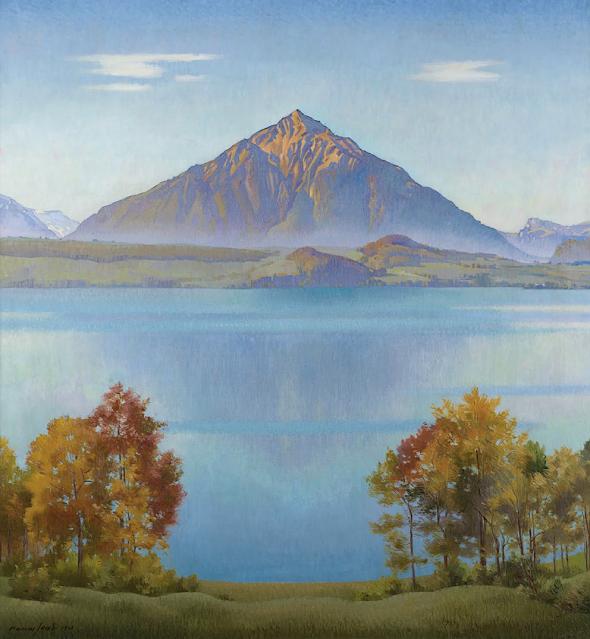MARCUS JACOBI (1891-1969)
Der Niesen (2, 362m - 7,749ft
Switzerland
In The Niesen, Lake Thun, Bernese Oberland, Switzerland, oil on canvas, 105 x 96cm, 1941,
Courtesy John Mitchell Fine paintings, London
The mountain
The Niesen (2, 362m - 7,749ft) is a mountain of the Bernese Alps in Switzerland. It overlooks Lake Thun, in the Bernese Oberland region, and forms the northern end of a ridge that stretches north from the Albristhorn and Mannliflue, separating the Simmental and Kandertal valleys. The literal translation of the German word "Niesen" is "sneeze", but the Niesen because of its shape, is often called The Swiss Pyramid. Administratively, the summit is shared between the municipalities of Reichenbach im Kandertal, to the south-east, and Wimmis, to the west and north. Both municipalities are in the canton of Bern. The summit of the mountain can be reached easily by using the Niesenbahn funicular from Mülenen (near Reichenbach). The construction of the funicular was completed in 1910. Alongside the path of the Niesenbahn is the longest stairway in the world with 11,674 steps. It is open only once a year to the public for a stair run.
The literal translation of the German word Niesen is sneeze. Because of its shape, the Niesen is often called the Swiss Pyramid. Since the 18th century, the Niesen was the subject of a number of paintings which will all be published in this blog, one by one. The Ferdinand Holder's paintings are the two first ones to have been published. The Niesen was also the subject of a number of paintings by Paul Klee, in which it was represented as a quasi-pyramid.
The painter
Born in Biel, Marcus Jacobi came from a family of piano manufacturers and went to study medicine in Bern before becoming a painter. In the 1920s he moved to Merligen on the northern shore of Lake Thun from where this summer panorama was painted. Floating between Ferdinand Hodler and Felix Vallotton, two of the giants of Swiss twentieth century painting, Jacobi’s landscape style fused elements of Realism and Symbolism. He became known for his views of the Niesen, the volcano-like peak which rises to well over 2,000 metres and is one of Switzerland’s most iconic mountains.
__________________________________________
2022 - Wandering Vertexes...
by Francis Rousseau







